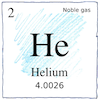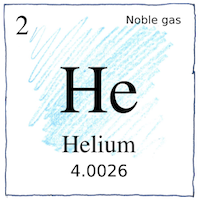Guntur, West Hampstead—Pierre Janssen,
Norman Lockyer,
Luigi Palmieri,
William Ramsay,
Per Teodor Cleve,
Nils Abraham Langlet
elements

|
Helium
I. Celestial Separately, Pierre Janssen and Norman Lockyer observed light from the solar chromosphere with a spectroscope during the eclipse in 1868 and found a bright yellow line that didn’t show for any element known to exist on Earth. Lockyer and Edward Frankland named the new element after the Greek word for the sun, hèlios. II. Terrestrial In 1882, Luigi Palmieri detected the yellow spectral line of helium in gases from lava of Mount Vesuvius. In 1895, Henry Meirs told William Ramsay that heating a mineral from Norway gave off a gas that might be nitrogen. Ramsay thought the gas might be argon, but his spectroscope showed a bright yellow line which showed the gas to be helium. Meanwhile, in France, both Per Teodor Cleve and Nils Abraham Langlet also discovered helium in the same mineral.
Atomic number 2
Almost a quarter of the universe is helium-4; however, helium is rare on Earth. In 1903, an oil well in Kansas struck a gas geyser that was almost two percent helium, resulting in helium production for helium-filled airships for World War I. Cooled liquid helium is a superfluid; with zero viscosity and zero friction, it creeps up surfaces to escape containers.
Noble
Helium is colorless, odorless, tasteless, non-toxic, inert, and monatomic. It’s the first of the noble gases, and it hardly inspires comparisons.



Why is helium rare on earth? It it light and it doesn’t combine with other elements, so it has floated off into space. What we have is produced by radioactive decay of uranium and thorium inside the earth. No minerals contain helium in their chemical formulae.
Norman Lockyer was the founder, in 1869, of the science journal Nature.
See also in The book of science:
Readings in wikipedia:
Other readings: